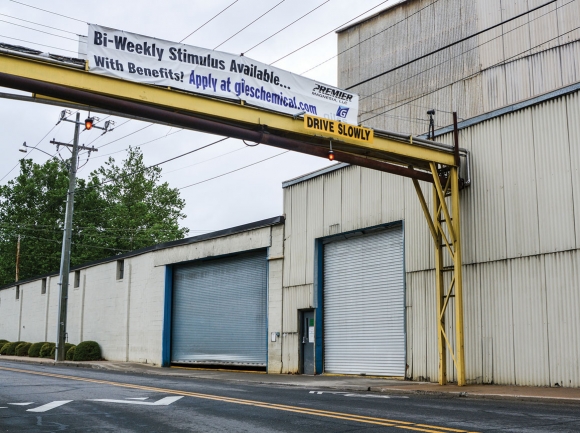Post-COVID employment rebounds, but where are the workers?
 A clever sign in Frog Level announces job openings at Giles Chemical. Cory Vaillancourt photo
A clever sign in Frog Level announces job openings at Giles Chemical. Cory Vaillancourt photo
You’ve seen the signs, on marquees and placards, up and down streets in towns across Western North Carolina — Now hiring! Competitive pay! Start today!
Those signs are a welcome relief compared to the signs on local businesses around this time last year that mostly said, “Closed,” but they’re also a sign of a deeper problem. Some local businesses are still having a tough time finding employees, to the extent that their capacity to serve customers has been impacted.
The tight labor market shows a lack of supply across almost all economic sectors, but some sectors were hit harder than others, as were some regions, leading to an uneven economic recovery that affects women, people of color and people with low levels of educational attainment the most.
After spending the previous three years at 4.5 percent or less, total civilian unemployment peaked in April 2020 at 14.8 percent of Americans over the age 20, according to the U.S. Bureau of Labor Statistics . That’s not the highest figure in U.S. history, but coming off a 50-year low , it is the highest in recent history.
Women and minorities bore the brunt of the layoffs; during that same month, the unemployment rate for women was 15.5 percent, versus 13.1 percent for men. Hispanics experienced 18.9 percent unemployment, African Americans 16.7 percent and Asians 14.5 percent, compared to 14.1 percent for whites.
Just as the national rate reached 14.8 percent, people without high school diplomas saw 21 percent unemployment. High school graduates with no college experience endured 17.3 percent unemployment, and those with some college experience or an associate’s degree were still above average at 15 percent unemployment. Workers with Bachelor’s degrees or more experienced unemployment levels of 8.4 percent.
Related Items
North Carolina fared slightly better than the nation as a whole, topping out at 13.2 percent unemployment in April 2020.
But of 17 Western North Carolina counties, only six — Avery, Clay, Macon, Polk, Transylvania and Yancey — performed better than the state that month.

As of April 2021, only Avery and Macon counties have returned to pre-pandemic levels; most others are within one point of where they were in April 2020, however, even a small increase in unemployment percentage represents a tangible human toll.
Take Haywood County, for example. In April 2019, the unemployment rate was a healthy 3.6 percent. In April 2021, it was 3.9 percent. That may be just three-tenths of a percentage point, but it’s an increase of almost 200 people, bringing the total number of unemployed in Haywood County to 1,106.
In the five-county region that makes up the Asheville Metro Statistical Area (Buncombe, Henderson, Haywood, Madison and Transylvania) it’s clear that the region’s manufacturing sector remained somewhat insulated from the economic effects of the pandemic. April 2019 employment totals hovered just over 22,000, but data from April 2020, revealed 19,500 people still working in the sector. April 2021 totals show almost full employment, at 21,400.
Not so for the region’s all-important tourism industry.
In April 2019, there were approximately 29,700 people employed in the leisure and hospitality sector but when Gov. Roy Cooper shut down bars, hotels and restaurants a year later, less than 13,000 people still had jobs. This past April, employment totals in that sector show a rebound to 24,100 employees, but most of those “help wanted” signs appear outside the same bars, hotels, and restaurants that spent much of 2020 closed.
Some employers believe it’s because of the additional $300 in federal unemployment benefits, but those won’t last forever — in fact, Hendersonville Republican Sen. Chuck Edwards has introduced a bill that would have North Carolina join the other 26 states that have opted out of the program.
Other employers believe that even if everyone receiving unemployment benefits came back to work, there would still be a labor shortage. They’ve begun holding job fairs, offering sign-on bonuses, creating relaxed schedules and yes, even offering higher pay.
Conversely, some workers have given themselves raises of their own — by taking advantage of continuing or professional education opportunities to move into better paying jobs in other fields.
Over the next few weeks, The Smoky Mountain News will explore the labor shortage from a variety of perspectives, across a variety of industries, throughout North Carolina’s western counties, hoping to answer that one simple question — where are the workers?













